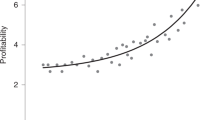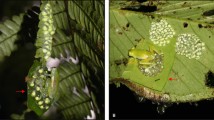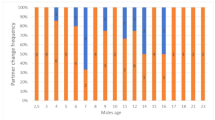Abstract
Female birds often copulate with males that are not their social partner, but why they do this is unclear1. Blomqvist et al.2 present evidence from three wader species showing that extra-pair fertilizations are more likely when social mates are genetically closely related. We argue, however, that their conclusions are undermined on technical and theoretical grounds, and that there is still no convincing evidence that extra-pair copulation in birds is influenced by the relatedness between partners.
Similar content being viewed by others
Main
Blomqvist et al. used a single multilocus (minisatellite) DNA-fingerprinting probe to estimate “genetic similarity”. Although multilocus probes will detect extra-pair paternity1 and maternity3 (brood parasitism), band-sharing coefficients (calculated by comparing bands on DNA fingerprints) are unreliable for determining the degree of genetic similarity between two individuals4. Blomqvist et al. present data that illustrate this problem, reporting that band-sharing coefficients between individual parents and their offspring vary between 0.31 and 0.79, when in fact their genetic similarity is always the same, as each parent passes half of its autosomal alleles to each offspring.
Multilocus DNA fingerprints have been used successfully to compare the mean genetic similarity of two samples3,5, but the results of Blomqvist et al. reveal two patterns — quasi-parasitism and kin recognition — that should be rare or absent in birds in general, and in waders in particular. They find evidence of quasi-parasitism in four of six extra-pair matings in common sandpipers (Actitis hypoleucos) and Kentish plovers (Charadrius alexandrinus), although not in western sandpipers (Calidris mauri).
Quasi-parasitism occurs when an extra-pair female with whom a male has copulated visits the male's nest and lays an egg. Of 130 bird species for which molecular analysis for parentage has been carried out1, only one (the sand martin, Riparia riparia)3 shows evidence of quasi-parasitism that is supported by behavioural observations. This is unsurprising, as R. riparia breeds in dense colonies where females nest only a few centimetres apart, offering opportunities for both quasi-parasitism and extra-pair paternity. The waders studied by Blomqvist et al., however, are territorial, with neighbours nesting tens to hundreds of metres apart, and are socially and (largely) sexually monogamous. Also, a larger study of common sandpipers using two multilocus probes and behavioural observations found no evidence of quasi-parasitism6.
As these waders lay no more than four eggs per clutch, and Blomqvist et al. found no evidence of supernumerary eggs in the clutches that they studied, pair males or extra-pair females must have removed an intact egg (each weighing ≥20% of adult body mass) to accommodate one from the extra-pair female. This would be an extraordinary physical feat for these birds and has not previously been reported in waders. The removed within-pair egg would almost certainly have been fertilized by the male, unlike that laid by the extra-pair female, for which the likelihood of the male's paternity would be lower.
Blomqvist et al. conclude that a pair member that detects a strong genetic similarity with its partner seeks an extra-pair mating as an adaptive tactic to avoid the costs of inbreeding. Although they do not estimate coefficients of relatedness (r) from their DNA fingerprints, their Fig. 1 indicates (using methods in ref. 4) that individual birds would have to have recognized their partner as third- or higher-order kin (r ≤ 0.125) in seven out of eight pairs with quasi-parasitism or extra-pair paternity. Having established this, the birds would then copulate with more distantly related individuals. However, the only (limited) evidence so far for kin recognition in birds involves first- and possibly second-order relatives, such as peacocks that recognize their brothers and half-brothers7.
Despite the potentially serious deleterious effects of inbreeding in wild bird populations, there is little to suggest that birds use kin discrimination to avoid inbreeding during primary mate selection8. Moreover, kin discrimination is unlikely in migratory birds such as waders that have low natal philopatry, as relatives rarely encounter one another.
Blomqvist et al.2 should have used microsatellite markers for their molecular analysis, which are more reliable for estimating coefficients of relatedness between individuals9, to be certain of the genetic relationship between mates and the incidence of quasi-parasitism in these waders. Even then, alternative interpretations are possible. Meanwhile, extra-pair mating in birds remains to be explained.
References
Griffith, S. C., Owens, I. P. F. & Thuman, K. A. Mol. Ecol. 11, 2195–2212 (2002).
Blomqvist, D. et al. Nature 419, 613–615 (2002).
Alves, M. A. S. & Bryant, D. M. Anim. Behav. 56, 1323–1331 (1998).
Reeve, H. K., Westneat, D. F. & Queller, D. C. Mol. Ecol. 1, 223–232 (1992).
Bensch, S., Hasselquist, D. & von Schantz, T. Evolution 48, 317–326 (1994).
Mee, A., Whitfield, D. P., Thompson, D. B. A. & Burke, T. Anim. Behav. (in the press).
Petrie, M., Krupa, A. & Burke, T. Nature 401, 155–157 (1999).
Keller, L. F. & Arcese, P. Am. Nat. 152, 380–392 (1998).
Queller, D. C., Strassmann, J. E. & Hughes, C. R. Trends Ecol. Evol. 8, 285–288 (1993).
Author information
Authors and Affiliations
Corresponding author
Rights and permissions
About this article
Cite this article
Griffith, S., Montgomerie, R. Why do birds engage in extra-pair copulation?. Nature 422, 833 (2003). https://doi.org/10.1038/422833a
Issue Date:
DOI: https://doi.org/10.1038/422833a
This article is cited by
-
An experimental increase in female mass during the fertile phase leads to higher levels of extra-pair paternity in pied flycatchers Ficedula hypoleuca
Behavioral Ecology and Sociobiology (2019)
-
Extra-pair copulations, intra-specific brood parasitism, and quasi-parasitism in birds: a theoretical approach
acta ethologica (2014)
-
Genetic mating system and timing of extra-pair fertilizations in the Kentish plover
Behavioral Ecology and Sociobiology (2004)
Comments
By submitting a comment you agree to abide by our Terms and Community Guidelines. If you find something abusive or that does not comply with our terms or guidelines please flag it as inappropriate.



